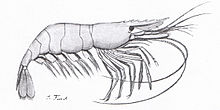Palaemon adspersus
| Palaemon adspersus | |
|---|---|
 |
|
| Scientific classification | |
| Kingdom: | Animalia |
| Phylum: | Arthropoda |
| Subphylum: | Crustacea |
| Class: | Malacostraca |
| Order: | Decapoda |
| Family: | Palaemonidae |
| Genus: | Palaemon |
| Species: | P. adspersus |
| Binomial name | |
|
Palaemon adspersus Rathke, 1837 |
|
| Synonyms | |
|
|
| External identifiers for Palaemon adspersus | |
|---|---|
| Encyclopedia of Life | 1040993 |
| ITIS | 96478 |
| WoRMS | 107613 |
Palaemon adspersus, commonly called Baltic prawn, is a species of shrimp that is frequent in the Baltic Sea, and is the subject of fisheries in Denmark. It is up to 70 mm (2.8 in) long, and lives in Zostera beds.
Palaemon adspersus is up to 70 millimetres (2.8 in) long, with a plain yellowish-grey body. The rostrum bears distinctive spots of pigment on its lower half.
Palaemon adspersus is uncommon over most of north-western Europe, but forms the basis of a significant fishery in the Danish straits. In the Baltic Sea, it can tolerate salinities as low as 5‰, but it overwinters in deeper, more saline waters offshore. In Denmark, P. adspersus is closely associated with Zostera (eelgrass) beds, and is replaced by Palaemon elegans where the eelgrass is lacking.
Carl Linnaeus described this species under the name Cancer squilla in his Systema Naturae (1758, 1761). As more genera were split from Linnaeus' Cancer, this species became known as Leander squilla, while the genus Palaemon was used for other species. In 1897, Mary Jane Rathbun realised that a type species for the genus Palaemon had been made in 1810 by Pierre André Latreille, and that the chosen species was Cancer squilla. This required the genus then known as Leander to become Palaemon, while the genus then known as Palaemon had to become Macrobrachium. Not all biologists followed the new nomenclature, and the confusion was eventually resolved by a ruling from the International Commission on Zoological Nomenclature (ICZN), which stated that the type species of Palaemon would be Palaemon adspersus.
...
Wikipedia
